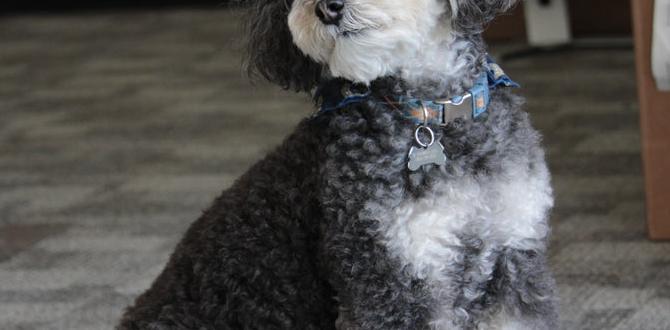Quick Summary: Effectively manage dog attention-seeking behavior with these proven tips: understand the why behind the behavior, provide sufficient physical and mental stimulation, reward calm behavior, establish clear boundaries, and never reward attention-seeking actions. This balanced approach builds a stronger bond and a happier dog.
Does your furry friend seem to have an endless supply of energy, but not always for the right things? You’re not alone! Many dog owners find themselves dealing with a pup who’s constantly nudging, barking, or pawing for attention. It can be frustrating, especially when you’re trying to focus on other tasks. But don’t worry, it’s a common dog behavior that can be understood and managed with the right approach. This guide will walk you through simple, effective strategies to help your dog feel loved and secure, while also learning to be content with quiet time. You’ll discover how to redirect their energy and build a more peaceful, enjoyable life together.
Understanding Your Dog’s Need for Attention
At its core, your dog’s attention-seeking behavior stems from their innate desire to connect with you, their beloved human. Dogs are social creatures, and their bond with their family is paramount. When they exhibit attention-seeking behaviors, they’re often communicating a need or a feeling, much like a child might. Understanding these underlying reasons is the first, crucial step towards finding effective solutions.
Why Does My Dog Seek My Attention So Much?
Several factors can contribute to your dog’s persistent need for your focus. It’s rarely out of spite; rather, it’s a signal that they need something or are feeling a particular emotion.
- Boredom and Lack of Stimulation: A dog without enough physical exercise or mental engagement will often look for ways to entertain themselves, and they’ve learned that your attention is a great reward.
- Loneliness or Separation Anxiety: If your dog doesn’t get enough positive interaction throughout the day, or if they have underlying separation anxiety, they might constantly seek reassurance and company.
- Seeking Comfort or Reassurance: Sometimes, a dog seeking attention might be feeling anxious, stressed, or uncertain about their environment. Your presence can be a source of comfort.
- Learned Behavior: This is a big one! If your dog has learned that barking, whining, nudging, or jumping gets them the attention they want (even negative attention like pushing them away), they will continue to use those tactics.
- Health Issues: While less common, persistent attention-seeking can sometimes be a sign of underlying pain or illness that your dog is trying to communicate.
- Basic Needs Not Met: Ensure your dog has access to fresh water, appropriate food, and has had opportunities to go to the bathroom. Sometimes, basic needs can manifest as attention-seeking behavior.
It’s important to differentiate between a dog genuinely wanting to play or interact and a dog exhibiting problematic attention-seeking. The key is to ensure their needs are met and to teach them appropriate ways to signal their desires.
The Art of Providing Sufficient Stimulation
A tired dog is a good dog, as the saying goes. When your dog’s physical and mental energy is depleted in a healthy, constructive way, they are far less likely to resort to nuisance behaviors to get your attention. This means being proactive about their daily needs.
Physical Exercise: More Than Just a Walk
While daily walks are essential, the type and intensity of exercise should be tailored to your dog’s breed, age, and energy level. Some dogs thrive on long hikes or strenuous runs, while others are content with shorter, more frequent outings or play sessions.
- Breed-Specific Needs: Herding breeds like Border Collies need more than just a stroll; they need activities that engage their minds. High-energy breeds like Huskies require significant daily exertion. Discuss your dog’s breed characteristics with your veterinarian or a professional trainer for tailored advice.
- Consistency is Key: Aim for at least 30-60 minutes of physical activity daily for most adult dogs. Puppies and senior dogs will have different needs.
- Variety is the Spice of Life: Mix up your routine. A vigorous game of fetch in the park, a hike in a new trail, or even a swim can be more engaging than the same old sidewalk loop.
- Safe Play Zones: Utilize fenced yards or secure dog parks for off-leash running and play, but always ensure your dog is well-socialized and remains under your supervision.
Mental Enrichment: Engaging Their Brain
Mental stimulation is just as vital as physical exercise. It prevents boredom, reduces anxiety, and can even help slow cognitive decline in older dogs. Think of it as a brain workout for your pup!
- Puzzle Feeders and Treat Toys: These are fantastic for making meal times or treat times more challenging and rewarding. Brands like KONG or Nina Ottosson offer a variety of engaging options.
- Sniffing Games: Dogs experience the world through their noses. Hide treats or their favorite toys around the house or yard and let them use their amazing sense of smell to find them. This is a calm, yet highly engaging activity.
- Training Sessions: Short, positive reinforcement training sessions (5-10 minutes) are excellent for mental stimulation. Teach new tricks, practice commands, or work on specific skills.
- Interactive Play: Games like “find the hidden toy” or “which hand is it in?” over-stimulate their minds and reinforce positive interaction with you.
- Chew Toys: Provide safe, durable chew toys. Chewing is a natural stress reliever for dogs and keeps them occupied.
A well-exercised and mentally stimulated dog is a fulfilled dog, and this fulfillment significantly reduces the drive to demand attention through disruptive behaviors.
The Power of Positive Reinforcement: Rewarding Calmness
One of the most effective ways to change your dog’s behavior is by rewarding the behaviors you want to see more of. This means actively looking for and reinforcing calm moments. This shifts the focus from punishing unwanted attention-seeking to encouraging desired interactions.
Catch Them Being Good
The core principle here is to reward your dog when they are not demanding your attention. This might seem counterintuitive at first, but it works by showing your dog that calm, independent behavior leads to pleasant outcomes.
- Identify Calm Moments: Look for times when your dog is lying down quietly, looking out the window without barking, chewing on a toy, or simply relaxing beside you without nudging.
- Deliver Low-Key Rewards: When you see these calm moments, offer a quiet word of praise (“Good boy/girl”), a gentle scratch, or a small, previously hidden treat. The key is that the reward doesn’t escalate their energy or demand more interaction if they aren’t ready.
- Timing is Everything: Deliver the reward immediately after you observe the calm behavior so your dog clearly associates the reward with that specific action.
- Reward Independence: This teaches your dog that they don’t always need your direct involvement to be content or to receive positive reinforcement. It builds their confidence in their own company.
Gradually Increase the “Difficulty”
Start by rewarding very short periods of calmness. As your dog begins to understand, gradually increase the duration you expect them to remain calm before receiving a reward. This might look like:
- Reward your dog for lying down quietly for 10 seconds.
- After a few successful repetitions, wait for 20 seconds before rewarding.
- Continue to slowly extend the time.
This process helps your dog learn to self-soothe and enjoy their own space, reducing the constant need to seek external validation from you.
Setting Boundaries and Clear Expectations
Dogs thrive on structure and predictability. Establishing clear boundaries teaches them what is acceptable behavior and when and how they can engage with you. This is not about being harsh, but about being consistent and fair.
What is “Attention Seeking” vs. “Just Wanting Interaction”?
It’s crucial to distinguish between your dog’s healthy desire for interaction and behaviors that are genuinely disruptive or demanding. For instance, nudging your hand while you read is attention-seeking. Bringing you a toy and sitting expectantly might just be them asking to play, which is a normal and desirable interaction!
Rules for Interaction
Decide as a household what constitutes appropriate ways for your dog to ask for your attention. Post these rules and ensure everyone in the family follows them.
- “Ask Nicely” Rule: Teach your dog a polite way to get your attention, such as sitting calmly in front of you. When they do this, acknowledge them.
- The “Ignore and Redirect” Strategy: For attention-seeking behaviors like barking, whining, or pawing when you are busy, the best approach is often to completely ignore them initially. Do not make eye contact, speak to them, or touch them. Wait for a brief pause in the behavior, and then calmly redirect them to a more appropriate activity (like a chew toy or a training cue).
- No Rewarding the Behavior: This is critical. If you give your dog attention (even negative), when they are engaged in unwanted attention-seeking, you inadvertently reinforce that behavior.
- “Wait Your Turn”: If you are petting one of your dogs and another demands attention by jumping or barking, do not give in. Wait until the demanding dog is calm and polite before offering them attention.
Consistency Across the Household
Inconsistency is a major stumbling block. If one family member allows the dog to jump for attention, and another scolds them, the dog will become confused. All members of the household must be on the same page and apply the same rules and strategies consistently. This is where external resources like those from the Humane Society can offer valuable guidance on positive reinforcement training methods.
Strategies to Avoid: The Pitfalls of Reacting
How you react to your dog’s attention-seeking behavior can inadvertently strengthen it. Understanding what not to do is just as important as knowing what to do.
The Danger of Negative Attention
To a dog, any attention is good attention, even if it’s negative. Shouting, scolding, or pushing your dog away when they are demanding your attention can still be perceived as interaction. They learn that this behavior still gets a reaction from you, making them more likely to repeat it.
- Don’t Yell or Punish: This can create fear and anxiety, potentially worsening the problem or leading to other behavioral issues.
- Don’t Push or Physically Reprimand: This can damage your bond and your dog’s trust in you.
- Avoid Giving In “Just This Once”: Once you start rewarding attention-seeking behavior, your dog learns that sometimes, if they are persistent enough, they will get what they want. This makes it harder to extinguish the behavior later.
The “Enabler” Trap
Sometimes, owners unintentionally encourage attention-seeking by always being available or by providing constant entertainment to prevent any perceived unhappiness in their dog. While well-intentioned, this can create a dog that is overly dependent and unable to entertain themselves.
- Don’t Play “On Demand”: While playtime is crucial, try to control when it happens. Instead of immediately dropping everything when your dog demands it, wait for a calm moment or cue them to “ask nicely.”
- Don’t Over-Socialize to the Point of Anxiety: While socialization is vital, ensure your dog also learns to be comfortable and content when left alone for short periods.
By avoiding these common pitfalls, you can ensure that your responses to your dog’s behavior are constructive and move you closer to your goal of a well-behaved companion.
Implementing a Plan: Step-by-Step Solutions
Putting these tips into practice requires patience and consistency. Here’s a plan to help you implement these strategies effectively.
Step 1: Observe and Identify
Before you change anything, take a week to observe your dog’s behavior. When are they seeking attention? What specific behaviors are they using? What are you doing when this happens? What are the triggers?
- Keep a “Behavior Log”: Note the time of day, the behavior, your response, and what happened before and after.
- Identify patterns: Do they act out when you’re on the phone? When they haven’t eaten? When it’s a certain time of day?
Step 2: Establish a Routine and Provide Enrichment
Based on your observations, create a structured daily routine that includes:
- Scheduled Exercise: Plan specific times for walks, play, or runs.
- Mental Stimulation Time: Dedicate 10-15 minutes daily to puzzle toys, training, or scent games.
- Feeding Schedule: Feed your dog at consistent times.
Step 3: Reinforce Calmness Proactively
Make it a habit to spot and reward quiet, calm behavior throughout the day, even when your dog isn’t specifically demanding attention. This builds a positive association with being settled.
Step 4: Implement the “Ignore and Redirect” Strategy for Unwanted Behaviors
When attention-seeking behavior (barking, pawing, nudging) occurs:
- Do NOT react: No eye contact, no talking, no touching.
- Wait for a pause: Even a second or two of silence or stillness is a window of opportunity.
- Redirect: Immediately offer a sanctioned toy, a training cue (“sit”), or a calm praise.
Step 5: Teach an Alternative Behavior
Actively teach your dog an appropriate way to ask for attention. This could be sitting politely, or touching a specific object (like a hand bell) with their paw.
- Train the cue: Reward them generously when they perform the desired “asking” behavior.
- When they use the new cue: Respond positively, fulfilling their need for interaction.
Step 6: Be Patient and Consistent
Behavior change takes time. There will be good days and bad days. The most crucial element is unwavering consistency from everyone in the household. This is where resources from organizations like the American Kennel Club (AKC) can offer additional guidance and support.
Troubleshooting Common Attention-Seeking Scenarios
Let’s look at some specific situations and how to apply these principles.
Scenario 1: Barking for Attention when You’re Working
Problem: Your dog barks incessantly while you’re on a video call or trying to get work done.
Solution:
- Before: Ensure they’ve had adequate exercise and mental stimulation.
- During: Completely ignore the barking. Use noise-canceling headphones if necessary. Wait for a pause, then calmly go to your dog and ask them to sit or lie down. Reward this calm behavior. If the barking persists, you may need to place them in another room with a long-lasting chew toy until you are finished.
- Long-term: Practice “settle” commands and reward independent quiet time.
Scenario 2: Pawing or Nudging for Affection
Problem: Your dog repeatedly nudges your hand or paws at you while you’re relaxing.
Solution:
- Ignore the Nudge: Don’t look, don’t talk, don’t pet.
- Wait for Stillness: As soon as they stop nudging, even for a second, give a calm “yes” and a gentle pat or treat.
- Teach an Alternative: Train them to gently rest their head on your lap or bring you a specific toy when they want affection.
Scenario 3: Whining and Pacing
Problem: Your dog whines and follows you around the house. This could indicate boredom, anxiety, or a learned behavior.
Solution:
- Rule out needs: Ensure they’ve had adequate potty breaks, food, and water.
- Increase Exercise/Enrichment: Are they getting enough physical and mental work?
- Ignore the Whining: Do not give them attention while they are whining.
- Reward quiet: When they stop whining and are calm, even for a moment, reward them.
- Consider Professional Help: If it’s constant and seems linked to anxiety, consult a veterinarian or a certified professional dog trainer for potential underlying separation anxiety. Organizations like the American Veterinary Society of Animal Behavior (AVSAB) offer resources on addressing anxiety.
Scenario 4: Jumping Up When You’re Busy
Problem: Your dog jumps on you when you’re occupied, trying to get your attention.
Solution:
- Turn Away: If they jump, immediately turn your back to them.
- No Contact: Do not make eye contact or speak.
- Resume Interaction When Calm: Once all four paws are on the floor, step away, and then you can re-engage.
- Teach “Off”: A cue like “off” can be useful, but always pair it with turning away if they jump.
These scenarios highlight that with consistent application of these principles, even persistent attention-seeking behaviors can be managed effectively.
A Table of Strategies: What to Do and What NOT to Do
To make it even clearer, here’s a quick reference guide.
| For Effective Attention Management | Common Pitfalls to Avoid |
|---|---|
| Do: Provide ample daily physical exercise. | Don’t: Underestimate your dog’s exercise needs. |
| Do: Offer consistent mental stimulation. | Don’t: Leave your dog bored or under-stimulated. |
| Do: Reward calm, independent behavior. | Don’t: Reward attention-seeking actions, even with negative attention. |
| Do: Establish clear, consistent boundaries. | Don’t: Be inconsistent with rules between household members. |
| Do: Teach and ask for polite behavior (e.g., sit). | Don’t: Yell, scold, or punish. |
| Do: Ignore unwanted attention-seeking behavior until a pause. | Don’t: Give in quickly for a moment of peace. |
| Do: Redirect to appropriate activities. | Don’t: Let them practice the unwanted behavior. |
| Do: Seek professional help if needed (vet, trainer). | Don’t: Ignore signs of potential anxiety or health issues. |
Frequently Asked Questions (FAQ)
Q1: How do I know if my dog is genuinely seeking attention or just wants to play?
A: Playful interactions usually involve a wagging tail, play bows, soft eyes, and bringing you toys. Demanding attention can sometimes be accompanied by whining, barking, pawing, nudging, or persistent staring, often when you are busy or unable to engage. It’s about the context and the manner in which they approach you.
Q2: My dog barks a lot for attention. What’s the fastest way to stop it?
A: The fastest way is often to withhold all attention (even negative) when they bark, and to ensure they have plenty of positive outlets for their energy and needs BEFORE they start barking. Reward calm, quiet behavior heavily. Avoid punishing the barking itself, as it often makes dogs more frantic.
Q3: Can I ignore my dog completely when they seek attention?
A: You can ignore the specific unwanted behavior (like barking or pawing) temporarily until there is a pause. You should never ignore your dog’s overall need for interaction, love, or basic care. The goal is to teach them the appropriate way to ask for engagement.
Q4: Will my dog get frustrated if I don’t give them attention immediately?
A: Initially, they might show a slight increase in their attempts. However, with consistent positive reinforcement for calm behavior, they will learn that waiting politely leads to better results than demanding immediately. Teaching patience is a valuable part of their training.
Q5: I have a very high-energy dog. How much exercise is enough?
A: This varies by breed, age, and individual dog. For high-energy breeds, it often means over an hour of vigorous activity per day, plus significant mental challenges. Consult your veterinarian or a professional trainer to determine the ideal amount and type of exercise for your specific dog.
Q6: What if my dog is attention-seeking because they are lonely?
A: If loneliness is suspected, focus on building a stronger routine of interaction when you are available. This includes dedicated playtime, training sessions, and affection. Ensure they are not left alone for excessively long periods. If separation anxiety is a concern, professional guidance from a vet or trainer specializing in anxiety is recommended.
Conclusion
Navigating your dog’s attention-seeking behaviors is a common journey for many pet parents, and it’s one that can ultimately lead to a deeper, more understanding relationship. Remember, your dog’s actions are their way of communicating. By becoming a keen observer of their needs, providing ample physical and mental stimulation, and consistently rewarding the calm, polite behaviors you desire, you are building a foundation of trust and clear communication. Implementing strategies like the “ignore and redirect” method, while also teaching them acceptable ways to ask for your affection, is key to transforming disruptive demands into harmonious interactions. Be patient with yourself and your furry companion; consistent effort will yield significant progress, leading to a happier, more balanced, and more fulfilling life together. You’ve got this!
Meet Elyse Colburn, the devoted canine companion and storyteller behind the enchanting world of “Tales, Tails, and Adventures Unleashed.” A passionate dog enthusiast with a heart full of paw prints, Elyse Colburn shares heartwarming tales and insightful adventures, celebrating the joy, loyalty, and endless antics that make every dog a true hero. Join Elyse Colburn on this tail-wagging journey, where every post is a love letter to our four-legged friends.





